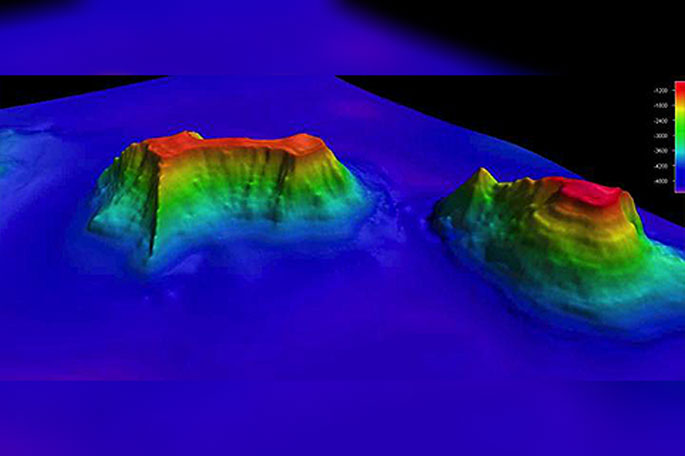Nelson-based fishing company Sealord are proposing a ban on fishing at the majority of the undersea mountains in New Zealand's exclusive economic zone.
Sealord chief executive Doug Paulin says the "Seamounts Count" proposal will see at least 127 of the 142 known seamounts protected within a conservation envelope.
It will mean that only the 15 remaining seamounts can be trawled.
Seamounts are volcanic features which rise at least 1000m high off the seafloor. Collectively, they form the largest wildlife habitat on earth, covering more of the earth's surface than rainforests, deserts, or tundra.
Fish congregate on the slopes of seamounts, as do corals and crustaceans, to eat the nutrients that are carried upwards from the depths of the oceans toward the warm surface.
Currently, just over 50 per cent of the seamounts in New Zealand's exclusive economic zone are protected.
"There's a common misconception that in the deep water we pretty much trawl wherever we want to trawl, but already there's a significant amount in conservation," says Paulin.
"But I believe it's actually not enough in order to give the New Zealand public the transparency and the confidence that we're doing the right thing."
Sealord is a major player in the deepwater fishing industry and Paulin says the closure will still leave enough other places for fishing companies to catch their quota .
"It is possible to achieve a balance; to conserve the marine environment and continue fishing a very small number of seamounts."
He says the proposal struck a balance in favour of conserving the seamounts that support a wide range of seafloor marine life.
"We only need to fish 11 per cent of the seamounts to support food, jobs and export earnings for New Zealanders."
Paulin says it means that new trawling grounds can't be opened, even if technology progressed to allow trawling at greater depths.
"I think it will give New Zealanders real confidence in the industry, knowing that almost 90 percent of those pristine biomass areas are protected."
Paulin says Sealord will discuss the proposal at the Government's Benthic Forum discussions, which begin on Tuesday.
He hopes the rest of the industry will be interested in the details of the proposal.
"I certainly wouldn't say that at this stage there's wholesale support across the board, but I do believe it's a position that we can reach agreement on amongst industry.
But the Deepwater Group, that represents the owners of fishing quota in New Zealand's deep water fisheries says the industry has always supported a balanced approach to marine conservation and sustainable seafood production.
Deepwater chief executive George Clement says trawling has only ever occurred on 15 of New Zealand's 142 seamounts.
In 2006 the government closed 30 per cent of New Zealand's exclusive economic zone to bottom trawling.
"In total, only 10 per cent of the EEZ has ever been used for food production. Annually, around one per cent of the EEZ is trawled, producing 700 million servings of natural seafood."
Clement says the most effective approach to fisheries management is to agree where to fish, what the rules are for fishing in these areas, and what ongoing research is needed to ensure these fishing activities remain sustainable.
"The future might mean that when looking at seamounts we only fish on these previously fished seamounts," he says.
"This proposition could be included in the conversation we are having with the Ministry of Primary Industries, the Department of Conservation and environmental NGOs, as part of the forum that is considering further controls on trawling within the EEZ."
NIWA has recorded 142 seamounts in New Zealand's exclusive economic zone - and is carrying out further research on underwater geographical features due to be released in May.
Half of the seamounts in New Zealand's waters are protected from bottom trawling through Benthic Protection Areas and Seamount Closure Areas.
And 71 of New Zealand's 142 seamounts are closed to all trawling by BPAs and SCAs.
Of the remaining 71 seamounts, 56 have never been trawled.
Karli Thomas of the Deep Sea Conservation Coalition in Aotearoa says bottom trawling on all seamounts needed to stop.
"We are facing an extinction crisis and underwater mountains are known to be oases of deep sea corals, sponges and other ancient and fragile deep sea life. We can't leave it up to the trawl sector of the fishing industry to pick and choose biodiversity hotspots to keep trashing."
Barry Weeber of Environment and Conservation Organisations says they want to see the government ban bottom trawling on seamounts and features altogether.
He says the New Zealand trawl industry is the only fleet still trawling on seamounts in the South Pacific high seas.
"If it wasn't for a handful of New Zealand vessels, the South Pacific seamounts and the amazing deep sea life they are home to would be safe from destructive trawl nets."



0 comments
Leave a Comment
You must be logged in to make a comment.